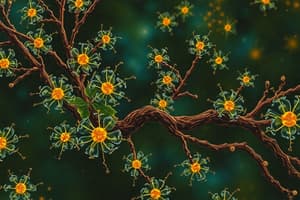Podcast
Questions and Answers
What is the primary difference between DNA and RNA?
What is the primary difference between DNA and RNA?
- DNA is found in the nucleus, while RNA is found in the cytoplasm
- DNA carries the hereditary information of the cell, while RNA is involved in protein synthesis (correct)
- DNA is involved in protein synthesis, while RNA carries hereditary information
- DNA is a single-stranded molecule, while RNA is a double-stranded molecule
What is the primary function of enzymes in metabolic pathways?
What is the primary function of enzymes in metabolic pathways?
- To synthesize new molecules
- To transport molecules across cell membranes
- To regulate gene expression
- To act as a catalyst for chemical reactions (correct)
What is the result of a protein's shape being altered due to changes in temperature, pH, or exposure to chemicals?
What is the result of a protein's shape being altered due to changes in temperature, pH, or exposure to chemicals?
- Mutagenesis of the protein
- Inhibition of the protein
- Activation of the protein
- Denaturation of the protein (correct)
What is the primary mechanism of cell signaling?
What is the primary mechanism of cell signaling?
What is the monomer that makes up proteins?
What is the monomer that makes up proteins?
What is the term for the web of interconnected reactions maintained by enzymes in cells?
What is the term for the web of interconnected reactions maintained by enzymes in cells?
What is the primary function of enzymes in cells?
What is the primary function of enzymes in cells?
What is the relationship between the product of one enzyme and the substrate for the next in metabolic pathways?
What is the relationship between the product of one enzyme and the substrate for the next in metabolic pathways?
What is the characteristic that makes enzymes highly specific for the reactions they catalyze?
What is the characteristic that makes enzymes highly specific for the reactions they catalyze?
What is the primary focus of the study of biochemistry?
What is the primary focus of the study of biochemistry?
What is the result of enzyme action on the rate of chemical reactions in cells?
What is the result of enzyme action on the rate of chemical reactions in cells?
What are the five key subtopics within biochemistry discussed in this article?
What are the five key subtopics within biochemistry discussed in this article?
Flashcards are hidden until you start studying
Study Notes
Biochemistry: An Introduction to Enzymes, Metabolic Pathways, Nucleic Acids, Protein Structure, and Cell Signaling
Biochemistry is the study of biological molecules and processes at the molecular level. It is concerned with understanding the chemical reactions and interactions that occur within living organisms, including the structure and function of various biological macromolecules. In this article, we will focus on five key subtopics within biochemistry: enzymes, metabolic pathways, nucleic acids, protein structure, and cell signaling.
Enzymes
Enzymes are powerful and highly specific catalysts that play a crucial role in determining the chemical transformations in cells. They bind to specific substrates, which are the reactants that bind to an enzyme, and convert them into products. Enzymes increase the rate of reactions, often by a factor of a million or more, without themselves being changed. This allows cells to control and regulate chemical reactions in a controlled manner. Enzymes are specific for the substrate upon which they act, and each type of enzyme within a class is highly specific for a single type of reaction.
Metabolic Pathways
Metabolic pathways are complex networks of chemical reactions in which the product of one enzyme becomes the substrate for the next. These pathways generate a wide range of molecules that cells need, such as energy and building blocks for the production of other biomolecules. Enzymes work in teams, with the product of one enzyme acting as the substrate for the next, ultimately forming a web of interconnected reactions that maintain cellular function.
Nucleic Acids
Nucleic acids are molecules made up of repeating units of nucleotides that direct cellular activities such as cell division. There are two types of nucleic acids: deoxyribonucleic acid (DNA) and ribonucleic acid (RNA). DNA carries the hereditary information of the cell, while RNA is involved in protein synthesis and other cellular processes. Each nucleotide is made up of a pentose sugar, a nitrogenous base, and a phosphate group.
Protein Structure
Proteins are long chains of different sequences of amino acids, which are the monomers that make up proteins. The functions of proteins are diverse, as there are 20 different chemically distinct amino acids that form long chains. Proteins can function as enzymes, hormones, and other molecules, depending on their specific sequence and structure. Protein shape is critical to its function, and changes in temperature, pH, or exposure to chemicals may lead to permanent changes in the shape of the protein, a process known as denaturation.
Cell Signaling
Cell signaling is a process by which cells communicate with each other and coordinate their activities. It involves the use of chemical signaling molecules, such as hormones, which are usually proteins or steroids, secreted by endocrine cells to control or regulate specific physiological processes, including growth, development, metabolism, and reproduction. Hormones bind to receptors on the surface of target cells, triggering a cascade of intracellular signaling events that ultimately lead to specific cellular responses.
In conclusion, biochemistry is a multifaceted field that encompasses the study of various biological molecules and processes. Understanding the structure and function of enzymes, metabolic pathways, nucleic acids, protein structure, and cell signaling is crucial for gaining insights into the complex chemical processes that occur within living organisms.
Studying That Suits You
Use AI to generate personalized quizzes and flashcards to suit your learning preferences.




